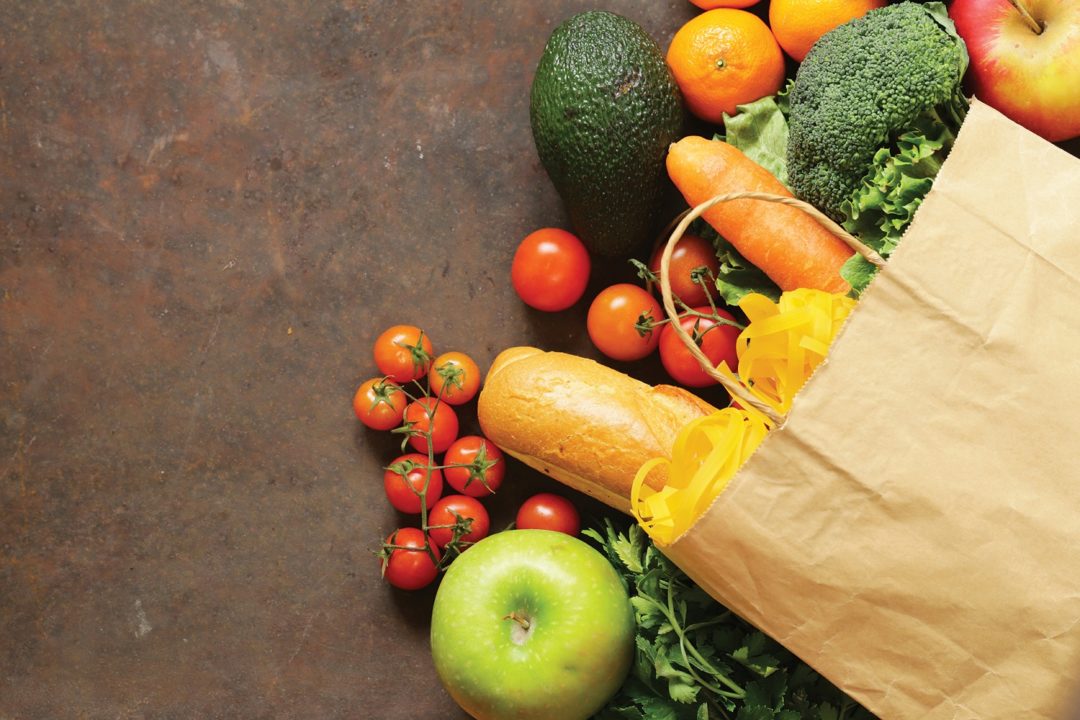Conventional Grocers Under PressureWhile the Amazon-Whole Foods deal was the most high-profile disruption of the year to U.S. grocery, conventional food retailers were already struggling with changing consumer shopping behavior; buying online and expecting rapid home delivery, or to be able to pick up at grocers’ “drive-through.” Convenience-seeking households were embracing meal-kit subscriptions, robbing conventional grocers of shopping visits and growth. Scrambling to adapt, major grocers were slowing store expansions and shifting investment to technology to keep up with the changes in demand.
Add to all this, price deflation in important categories such as dairy, meat, and poultry, which put downward pressure on already-thin profit margins, and risked triggering a price war. To top it all off, non-traditional hard discounters Aldi and Lidl, were in rapid expansion mode, forcing grocers in their markets to lower prices further.
Between deflation, grocery sales escaping to the internet, and competition from non-traditional discount channels, the 37,886 conventional grocers we track annually in the Retail Insights’ Retail Universe actually lost $2.58 billion in sales, or about four-tenths of one percent (-0.4%), to end 2017 at $647.87 billion, down from $650.46 billion in 2016. But natural organic sales continued to grow.
 Results for Eight Retail ChannelsThis year’s Retail Universe tracked calendar year 2017 natural organic sales through 111,939 stores in eight retail channels including club stores such as BJ’s, Costco and Sam’s Club; drugstore chains CVS, Rite Aid, Walgreens, and independent druggists; mass merchants Target and Walmart; conventional supermarkets including Kroger, Publix, Safeway, Wegmans and others; supernatural retailers Fresh Thyme, Sprouts Farmers Markets, Whole Foods Market and others; vitamin chain stores GNC and Vitamin Shoppe; “compact” grocers — those stores under 20,000 square feet — including Trader Joe’s and Natural Grocers by Vitamin Cottage; and independent natural retailers and coops. (Please see the 2018 Retail Universe table on the lower left.)
Results for Eight Retail ChannelsThis year’s Retail Universe tracked calendar year 2017 natural organic sales through 111,939 stores in eight retail channels including club stores such as BJ’s, Costco and Sam’s Club; drugstore chains CVS, Rite Aid, Walgreens, and independent druggists; mass merchants Target and Walmart; conventional supermarkets including Kroger, Publix, Safeway, Wegmans and others; supernatural retailers Fresh Thyme, Sprouts Farmers Markets, Whole Foods Market and others; vitamin chain stores GNC and Vitamin Shoppe; “compact” grocers — those stores under 20,000 square feet — including Trader Joe’s and Natural Grocers by Vitamin Cottage; and independent natural retailers and coops. (Please see the 2018 Retail Universe table on the lower left.)Overall, these grocers and nutritional retailers added $3.854 billion in natural organic sales, to reach $79.061 billion in 2017 from $75.206 billion in 2016; a 5.1% increase. This represents a 12.2% share of the $647.8 billion in total food store sales. Nearly one out of every eight retail grocery dollars now buys something natural or organic.
By now, it should surprise no one that natural organic foods continue to outpace inflation and the growth rate of conventional foods. Consumers are redefining quality in food, buying fewer and fewer highly processed foods, and more and more natural and organic foods. As a result, well over 100,000 U.S. retail stores now offer some meaningful assortment of natural and organic products. (Note: Some totals may not foot due to rounding.)
Natural Market ShareHow did our $79 billion in natural sales break out by channel? Well, as you might expect, supernaturals including Earth Fare, Fresh Thyme, Sprouts Farmers Markets, Whole Foods Market and others maintained their number one position, adding $1.52 billion to total $23.5 billion, for an industry-leading 29.75% natural market share. Compared to 2016, supernaturals grew by 97 stores and added 2.167 million square feet, as most of these big natural players built new stores.
In second place, by virtue of their sheer large number of stores — 37,886 — conventional supermarkets boosted their natural organic sales by $1.77 billion, to $15.459 billion, grabbing a 19.55% natural market share, and securing the number two spot.
At 6,561 stores, independent natural retailers and coops lost a net 13 stores in 2017 (minus two-tenths of one percent, -0.2%), but average store size increased by 4%, to 3,712 square feet gross lease area, up from 3,563 square feet in 2016. And sales for independents grew by $458.1 million, to $11.481 billion from $11.023 billion in 2016, capturing a third-place 14.52% natural market share. For an in-depth look at the independent natural sector, please see the just-released "2018 40th Annual WholeFoods Magazine Retailer Survey", beginning on page 38 of this issue. As you’ll read in the Survey, independent natural retailers continue to make themselves relevant to quality-seeking shoppers, are optimistic about the current year, and have ambitious expansion plans.
Close on the heels of independents, in fourth place, are what the Retail Universe calls “compact” grocers—those retailers whose stores are no larger than 20,000 square feet; a little less than half the size of a typical 45,000-square-foot conventional supermarket. This group includes a couple of key players: Natural Grocers by Vitamin Cottage and Trader Joe’s, among others. In 2017, compact grocers sold $11.4 billion, up $336 million from $11.064 billion in 2016; reaching a 14.42% natural market share.
Next up, in a distant fifth place, mass merchandisers Target and Walmart, secured a 6.46% natural market share, adding $216 million in sales, to $5.107 billion, up from $4.891 billion in 2016.
In sixth place, club stores BJ’s, Costco and Sam’s Club, reached a 6.08% natural market share, adding $221 million to $4.807 billion in sales, up from $4.585 billion in 2016. Overall, even though Costco added stores, the club channel lost 25 stores (-1.85%), as Sam’s Club opened 13 stores in 2017, but in January of 2018 announced the closure of 63 stores, for a net loss of 50 stores. We reflect the new, lower total of 597 Sam’s Club stores in the 2018 Retail Universe.
The pharmacy channel struggled in 2017, shrinking by 201 stores (-0.33%), and shedding $6.2 million in natural sales, to $3.841 billion, and ending in seventh place with a 4.86% natural market share.
Vitamin Chains Hit HardVitamin chain stores had the roughest year of all eight retail channels we follow in the Retail Universe. The channel was plagued by chronic negative quarterly comparable-store sales comparisons for most of the year. After a multi-year struggle, Vitamin World declared bankruptcy in September, 2017, ultimately closing 265 stores, leaving just 156 units open. GNC also reduced the number of corporate and franchise stores by 87. Even though Vitamin Shoppe added 33 units, overall, the vitamin chain channel lost a net 319 stores, or 5.45% of its store base, and shrank by $665.8 million in sales, a loss of (-16.2%). The channel closed 2017 with $3.441 billion in sales, for a 4.35% natural market share, eighth place out of the eight channels we track in the Retail Universe.
Perhaps the challenges we are seeing in the vitamin chain channel; difficulty maintaining customer counts, is similar to what we found in this year’s Retailer Survey (beginning on page 38), where stores that sold mostly supplements and few foods also experienced sales declines.
Natural MilestonesSquare footage dedicated to selling natural organic products reached 135.8 million square feet in 2017, or 4.32% of the total 3.147 billion square feet gross lease area of the 111,939 stores the Retail Universe tracked this year. This means that natural organic products — which now make up 12.2% of all food store sales — are nearly three times as efficient per-square-foot as all products sold at retail.
Total natural square feet in service in 2017 increased by 4,281,800 square feet, to total 135.8 million square feet, up 3.3% from the 131.5 million natural square feet in 2016. This compares nicely to the 5.1% increase in 2017 natural organic sales, and suggests that natural retailers are not overbuilding their stores. At 2.16 million new square feet, the supernatural channel added almost exactly as much as the 2.11 million new square feet in all seven of the other retail channels.
For all 111,939 retail stores, the average space dedicated to natural organic products is 1,214 square feet, with average annual sales of $706,288 per store, and $582 per gross-lease-area square foot; all record highs as measured by the Retail Universe.
Online SalesAs online sales continue to grow, retailers are beginning to report their online sales as a percentage of total revenues. For 2017, GNC generated an estimated $221.9 million in online sales, and Vitamin Shoppe captured $126.8 million in sales direct to consumer. The Retail Universe takes these online nutritional sales into account.
Among other retailers, Kroger, which owns the nutritional supplement website, Vitacost, also has significant natural sales through this online portal. Walmart and Target, while not breaking out online nutritional sales are likely significant players, with $9.5 billion and $3.0 billion in overall online sales, respectively, for all product categories offered by these two mass merchants. And last, but most certainly not least, Amazon, with its massive in-house and third-party online market, may be the biggest nutritional online player. Perhaps Mr. Bezos will share that number with us one of these days.JJ
Jay Jacobowitz is president and founder of Retail
 Insights®, a professional consulting service for natural products retailers established in 1998, and creator of Natural Insights for Well Being®, a holistic consumer marketing service designed especially for independent natural products retailers. With 40 years of wholesale and retail industry experience, Jay has assisted in developing over 1,000 successful natural products retail stores in the U.S. and abraod. Jay is a popular author, educator, and speaker, and is the merchandising editor of WholeFoods Magazine, for which he writes Merchandising Insights and Tip of the Month. Jay also serves the Natural Products Association in several capacities. Jay can be reached at (800)328-0855 or via e-mail at jay@retailinsights.com.
Insights®, a professional consulting service for natural products retailers established in 1998, and creator of Natural Insights for Well Being®, a holistic consumer marketing service designed especially for independent natural products retailers. With 40 years of wholesale and retail industry experience, Jay has assisted in developing over 1,000 successful natural products retail stores in the U.S. and abraod. Jay is a popular author, educator, and speaker, and is the merchandising editor of WholeFoods Magazine, for which he writes Merchandising Insights and Tip of the Month. Jay also serves the Natural Products Association in several capacities. Jay can be reached at (800)328-0855 or via e-mail at jay@retailinsights.com.Published in WholeFoods Magazine March 2018










